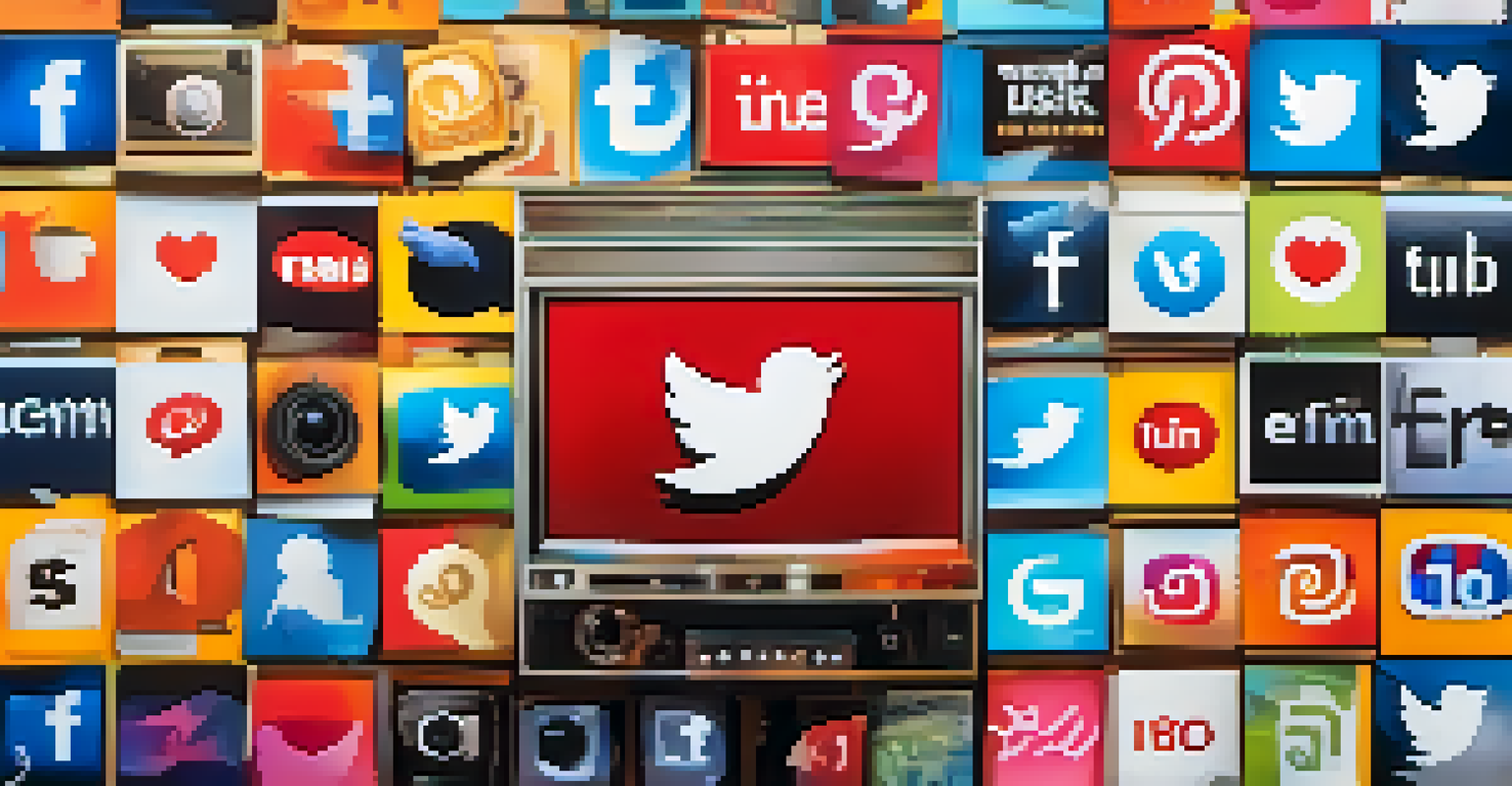The Influence of Television on Film Trailer Evolution

The Birth of Film Trailers: A Historical Context
Film trailers have a rich history that dates back to the early 1900s. Initially, they were short clips showcasing upcoming films, often shown in theaters before the main feature. As cinema evolved, so too did the methods of promoting films, leading to the development of trailers as we know them today.
Film trailers are the first glimpse audiences get of a movie, and they set the tone for the entire viewing experience.
Television emerged in the mid-20th century, bringing with it a new platform for film promotion. With the rise of TV, filmmakers began to realize that they could reach audiences directly in their homes, sparking a shift in how trailers were created and distributed. This allowed trailers to become more than just previews; they evolved into a vital marketing tool.
The influence of television on film trailers grew as networks began airing film previews during prime time. This not only increased the visibility of upcoming films but also encouraged filmmakers to craft trailers that could capture the attention of a more diverse audience. Thus, the seeds for future trailer evolution were sown.
Television's Role in Shaping Trailer Content
Television has had a significant impact on the content of film trailers. The need to capture viewer attention quickly has pushed filmmakers to create trailers that are more dynamic and engaging. This shift was influenced by the fast-paced nature of television programming, where grabbing the audience's attention in seconds is crucial.

As a result, trailers began to incorporate more dramatic cuts, catchy music, and compelling narratives. Filmmakers adopted techniques from TV commercials, such as utilizing cliffhangers and high-energy visuals, to entice viewers. This evolution has made trailers a more thrilling experience, akin to watching a mini-movie.
Trailers Evolve with TV Influence
Television's fast-paced nature has pushed filmmakers to create more dynamic and engaging trailers that mimic TV storytelling techniques.
Moreover, the integration of television-style storytelling into trailers has allowed filmmakers to showcase a film's tone and genre more effectively. By mimicking the pacing and style of popular TV shows, trailers can evoke emotions and intrigue, making viewers more likely to watch the full film.
The Impact of TV Genres on Trailer Structure
Different television genres have influenced the structure and style of film trailers. For example, the popularity of reality TV has led to a more casual and relatable approach in some trailers. This reflects a shift toward authenticity, as audiences increasingly favor genuine storytelling over purely cinematic experiences.
In the age of streaming, the trailer has become an essential tool for filmmakers to entice viewers and stand out in a crowded digital landscape.
Conversely, the rise of serialized drama has encouraged filmmakers to create trailers that emphasize character arcs and plot development. By mirroring the storytelling techniques found in popular TV dramas, trailers can build anticipation and emotional investment before a film's release. This has resulted in a more sophisticated and layered approach to trailer creation.
Additionally, the success of action-packed series has prompted trailers to adopt faster editing rhythms, thrilling visuals, and powerful soundtracks. This alignment with television trends means that trailers are now crafted not just to inform, but to excite and engage potential viewers.
The Digital Age: Streaming and Trailer Evolution
With the advent of streaming services, the way trailers are distributed and consumed has changed dramatically. Platforms like Netflix and Hulu have made trailers an integral part of their user experience, often featuring them prominently on their homepages. This accessibility has increased the importance of a strong trailer in attracting viewers to new content.
As a result, trailers are now tailored specifically for digital audiences, often designed to be short and to the point. This aligns with online viewing habits, where potential viewers may scroll through content quickly. The challenge for filmmakers is to create enticing trailers that can capture attention in mere seconds, similar to viral video content.
Streaming Changes Trailer Dynamics
The rise of streaming services has transformed how trailers are distributed, making them a crucial part of attracting digital audiences.
Furthermore, streaming platforms often use data analytics to refine their trailers based on viewer behavior. By understanding what captivates audiences, filmmakers can adjust their trailer content to ensure maximum engagement, leading to an even more strategic approach in today's digital landscape.
The Rise of Social Media and Its Effect on Trailers
Social media has revolutionized how trailers are promoted and shared. Platforms like Twitter, Instagram, and TikTok allow trailers to reach vast audiences almost instantly. This phenomenon has led to a more viral approach in trailer marketing, where trailers can trend and generate buzz far beyond traditional advertising methods.
Additionally, the format of trailers has adapted to fit social media platforms. Shorter clips, teasers, and even behind-the-scenes footage are shared to engage audiences and encourage sharing. This strategy has resulted in trailers that are not only promotional tools but also social media content designed to resonate with users.
As a result, filmmakers are now more conscious of how their trailers will perform across various platforms. This means considering how to create compelling visuals that are easily shareable, further blurring the lines between traditional film marketing and modern social media strategies.
Viewer Engagement: The Role of Audience Feedback
Viewer feedback has become increasingly important in the evolution of film trailers. With the rise of online platforms, audiences can now share their opinions and reactions almost instantly. This immediate feedback loop allows filmmakers to gauge public interest and adjust their marketing strategies accordingly.
For instance, trailers that resonate well with audiences can lead to increased excitement and viewership, while less popular trailers may prompt filmmakers to rethink their approach. This responsiveness to audience reactions has led to trailers that are more attuned to viewer preferences, ultimately enhancing their effectiveness in promoting films.
Social Media Shapes Trailer Strategy
Social media platforms have revolutionized trailer promotion, leading to shorter, more shareable content that engages audiences effectively.
Moreover, this engagement extends to the creation process itself, with some filmmakers even involving audiences in pre-release feedback sessions. By understanding what captivates potential viewers, filmmakers can refine their trailers to ensure they resonate with the target audience, making the entire process more collaborative.
The Future of Film Trailers: Trends to Watch
Looking ahead, we can expect film trailers to continue evolving in response to technological advancements and changing viewer preferences. As virtual reality (VR) and augmented reality (AR) gain traction, we may see trailers that offer immersive experiences, allowing audiences to engage with the film's world before its release.
Additionally, as personalization becomes more prevalent in digital marketing, trailers may become increasingly tailored to individual preferences. This could mean customized trailers that highlight elements specific to viewers' tastes, making the trailer experience more unique and engaging.

Lastly, as global audiences become more interconnected, we can anticipate a blend of cultural influences in trailers. Filmmakers are likely to create trailers that appeal to diverse audiences, showcasing a variety of storytelling styles and techniques that reflect a global cinematic landscape.